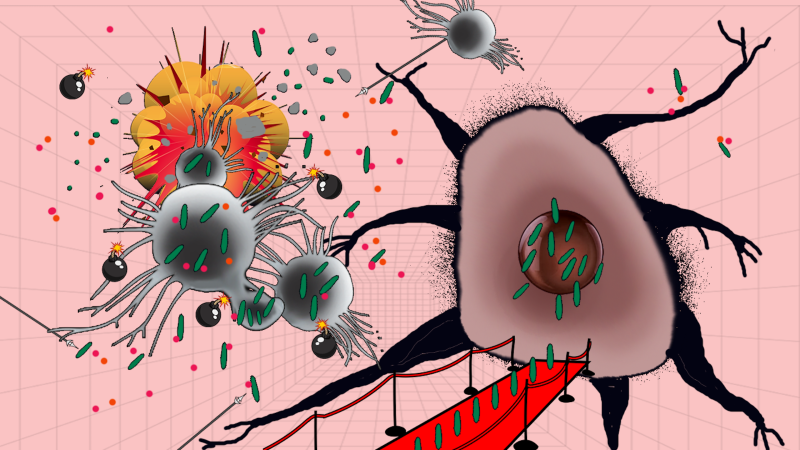
Macrophages (in grey) at war with Mycobacterium tuberculosis (in green), while a mesenchymal stem cell (in pink) provides a red carpet welcome to the bacteria. [Image Credits: Savitha Sekhar Nair]
Human Mesenchymal Stem Cells found to favour the survival of tuberculosis bacteria, instead of fighting it.
Every kind of cell in our body has a specific role. For instance, macrophages — a type of white blood cells — are the first responders to the site of infection. They recognise and destroy invading pathogens and damaged body cells. Mesenchymal stem cells, on the other hand, are involved in replenishing and repairing internal body parts including the skeletal parts of our body, such as cartilage and bone. They also modulate our immune response against infections and hence targeted to treat conditions like cancer. Now, a recent study may turn this belief upside down!
In a startling discovery, researchers from the ICGEB, in collaboration with scientists from All India Institute of Medical Sciences, New Delhi, have found out that these mesenchymal stem cells have a dark secret. Instead of protecting our body when Mycobacterium tuberculosis—a bacteria that causes tuberculosis—invades, these cells offer them a haven. The study, published in Nature Communications, reveals that mesenchymal stem cells protect the bacteria from the action of drugs and other immune cells of our body. Et tu, Brute?
When the bacteria enters our body, resident macrophage cells, found in the lungs, are generally the first responders. They sense the infection and engulf the bacteria. Most engulfed bacteria are killed inside the macrophages. However, this is not quite the case with the crafty Mycobacterium tuberculosis. It not only prevents itself from getting destroyed inside the macrophage but also conveniently uses the cellular components of the macrophage for its own growth and replication.
The battle does not end there — the infected macrophages and the immune cells form an inflammatory mass known as a tuberculosis granuloma. The macrophage sends out SOS signals to the immune system to send a backup. One such backup is the mesenchymal stem cells. They can bring down the inflammation and control the havoc created inside the granuloma. The immune system kills the macrophage because of its state of infection, and the bacteria emerging from the macrophage start invading other cells, including the mesenchymal stem cells. Ideally, one would expect these stem cells to work in tandem with the body and help get rid of the bacteria. But that's where friend turns foe!
Scientists have observed that fighting tuberculosis with drugs is a hard battle.
"Tuberculosis drugs are amazingly effective in lab studies but not during treatment. What takes only two days in cell culture takes around six months in a patient," says Dr. Dhiraj Kumar. He is a Group Leader and senior scientist at ICGEB and the lead author of the study. For a long time, scientists were looking at what protects the bacteria in humans from drugs. "This study describes most of that environment," he says.
The current study found that mesenchymal stem cells and other mediator molecules, including IFNγ and TNFα, are responsible for providing this safe environment for the bacteria. IFNγ and TNFα are molecules secreted in the body during inflammation and are known to kill the bacteria in macrophages. Instead, they protected the bacteria from internal immune system attacks and external drugs while harbouring them.
"It was a puzzling discovery," exclaims Dr Kumar. "We repeated the experiments multiple times and introduced a set of controls to establish that this is happening. I did not believe the data because it was much against the literature. It took us some time to come to terms with it."
The tuberculosis bacteria benefit in many ways by entering the mesenchymal stem cells. Firstly, these cells do not produce reactive oxygen species, which are toxic to the bacteria. Secondly, unlike other cells, they have long lives, which allow the bacteria to establish a semi-permanent, safe residence until they move out to attack other cells. Additionally, in the stem cells, the bacteria can tolerate anti-tuberculosis drugs and IFNγ and TNFα.
The findings have severe implications on tuberculosis control. About 15 of the current vaccines against the disease in different stages of clinical trials rely on our body to produce different levels of IFNγ and TNFα as they fight against the bacteria. However, now that we know these molecules play an inverse role, it would be tricky for the vaccines to work as desired. The efficacy of the vaccines, including BCG, may have been compromised due to the interplay between IFNγ and TNFα, mesenchymal stem cells and the bacteria. Hence, vaccine and drug developers will have to develop robust antidotes that can outsmart the bacterial mechanisms.
This article has been run past the researchers, whose work is covered, to ensure accuracy.






